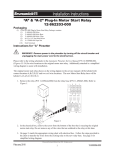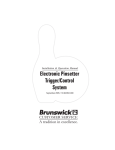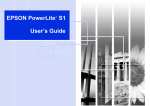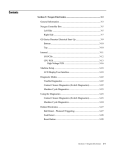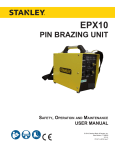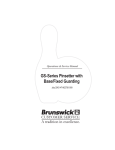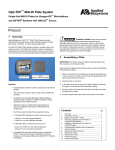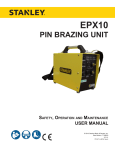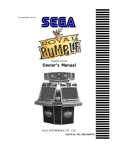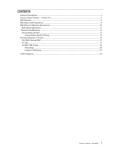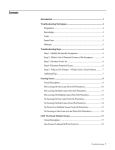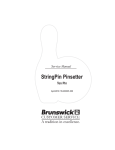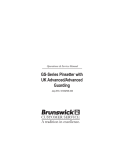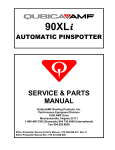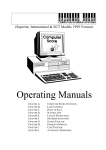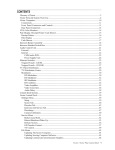Download - Brunswick
Transcript
Contents Section 4: Pinsetter Cycles ................................................................. 4-3 General Information ........................................................................ 4-3 Cycles .............................................................................................. 4-8 First Ball - Strike Cycle ....................................................... 4-8 First Ball - Standing Pins Cycle ........................................ 4-11 First Ball - Short Cycle ...................................................... 4-13 First Ball - Out-of-Range................................................... 4-15 First Ball - Foul ................................................................. 4-17 Second Ball - Single Detect ............................................... 4-19 Second Ball - Double Detect ............................................. 4-21 Second Ball - Out-of-Range .............................................. 4-23 Section 4: Pinsetter Cycles 4-1 Intentionally Blank Page 4-2 Section 4: Pinsetter Cycles Section 4: Pinsetter Cycles General Information The GS Certified Pre-owned Pinsetter is capable of performing many different cycles in reaction to a bowler throwing a ball. Before the pinsetter can begin one of these cycles, The following events must occur: 1. The pinsetter must be turned on, waiting for a ball. 2. The following conditions must be met: a. b. c. d. Table is up (“A” switch is closed) Sweep is forward (“SM” switch is closed) Sweep is up (“G” switch is not closed) Spotting tongs are fully open (“ST” switch is closed) To begin a cycle a bowler must throw a ball, the pinsetter reacts as follows: 1. The ball detect “sees” a ball and sends a pulse to the Pinsetter CPU. 2. The ball door solenoid energizes to lock the ball door for three seconds. 3. The sweep release solenoid energizes dropping the sweep. 4. Once sweep wagon lowers completely to the guarding position the “G” switch closes. 5. The table motor runs counterclockwise to start the cycle, causing the switch cluster cam to leave the A switch and rotate toward the “B” switch. Every cycle can be divided into three segments Refer to Figure 4-1. The first segment is the detection stroke of the cycle. Figure 4-2. In this segment, the table is lowered to detect or find out the results of the ball hitting the pins. The sweep segment occurs after the table is raised, during this segment the sweep clears all the deadwood from the pin deck and flat gutters. Figure 4-3. The final segment is the preparation stroke in which the pinsetter readies itself for the next ball. This may be a short stroke where pins are respotted back onto the pin deck if they were lifted by the table during the detection segment or it may be a long stroke where new pins are set on the pin deck in preparation for a new frame. Figure 4-4. Section 4: Pinsetter Cycles 4-3 A (1) (2) (3) (4) (5) (6) (7) DETECTION SWEEP PREPARATION COUNTERCLOCKWISE CLOCKWISE STANDING PIN HEIGHT NEW PIN SETTING HEIGHT A Section 4: Pinsetter Cycles A A (6) STANDING PIN HEIGHT (6) STANDING PIN HEIGHT B C D (4) CCW Figure 4-1. Cycle Segments 4-4 (3) PREPARATION (2) SWEEP (1) DETECTION D C B (2) SWEEP (5) CW (7) NEW PIN SETTING HEIGHT (6) MOVEMENT OF TABLE A A B C D (7) CCW ABCDA Figure 4-2. Detection Stroke (1) SWITCH “C” (2) SWITCH “B” (3) (4) SWITCH “A” (7) COUNTERCLOCKWISE (5) SWITCH “D” (6) CAM ROTATING COUNTER CLOCKWISE MOVEMENT OF TABLE Section 4: Pinsetter Cycles 4-5 Figure 4-3. Sweeping Deadwood. (1) SWITCH “C” (4) SWITCH “A” 4-6 Section 4: Pinsetter Cycles (2) SWITCH “B” (5) SWITCH “D” (3) CAM STOPPED (9) SWITCH CLUSTER ROTATION (10) MOVEMENT OF TABLE (8) LONG STROKE (6) SHORT STROKE A A A A OR OR D C B B D C (7) CW (7) CW ADCBA (8) LONG STROKE Figure 4-4. Preparation (1) (4) (7) (10) SWITCH “C” SWITCH “A” CLOCKWISE MOVEMENT OF TABLE (2) SWITCH “B” (5) SWITCH “D” (8) LONG STROKE (3) (6) (9) CAM ROTATING CLOCKWISE SHORT STROKE SWITCH CLUSTER ROTATION Section 4: Pinsetter Cycles 4-7 Cycles There are five first ball cycles and three second ball cycles. Additional cycles are available if a scoring system is connected to the pinsetters. The first ball cycles are: 1. 2. 3. 4. 5. First Ball - Strike First Ball - Standing Pins First Ball - Short Cycle First Ball - Out-Of-Range First Ball - Foul The second ball cycles are: 1. 2. 3. Second Ball - Single Detect Second Ball - Double Detect Second Ball - Out-Of-Range First Ball - Strike Cycle A strike cycle results when a bowler is successful in knocking down all the pins with the first ball. The pinsetter will sweep any deadwood into the pit and set ten new pins onto the pin deck. The following is a complete description of this cycle. Refer to Figure 4-5. 4-8 Section 4: Pinsetter Cycles 1. A ball detect occurs. 2. In response to the ball detect signal the sweep release solenoid energizes to lower the sweep into the guard position actuating switch “G”. The ball door solenoid energizes, locking the ball door for three seconds. 3. The table motor runs counterclockwise. The cam on the table shaft will leave switch “A” moving toward switch “B”. 4. As the table lowers “OOR” switch closes to indicate the table entered the detection area. 5. The table will make a short stroke as it stops on the stroke limiter plate. 6. At switch “B”, the Pinsetter CPU reads the pin holder switches and determines that no pins were left standing. The Pinsetter CPU sends pinfall information (a strike) to the automatic scorer (if installed). 7. The cam passes switch “C” with no action. 8. As the cam actuates switch “D”, the pin holder solenoids energize to open the grippers. 9. As the table is lifted to its raised position, the open grippers push up on the pin release levers, causing pins to drop into the pin holders. Actuation of the pin holder switch by the pin causes the solenoid to deenergize, closing the gripper. Actuation of switch “A” caused the table motor to turn off. 10. The sweep motor turns on, pulling the sweep back then forward to clear the deadwood. When the sweep wagon is fully forward once again, switch “SM” closes causing sweep motor to turn off. 11. The table motor runs clockwise and the cam leaves the switch “A” and travels to switch “D.” 12. As the table starts to lower, the stroke limiter solenoid is energized causing the stroke limiter plate to be pulled away from the T-stop. This allows the table to go down to the pin deck, and releases the swing shafts on the table allowing the pin holders to go into the vertical pinsetting position. 13. The cam passes switch “D” and at switch “C” pin holder solenoids energize to open the grippers and leave the pins on the pin deck. At switch “B” the solenoids de-energize, closing the grippers. 14. As the table continues to rise, the pin holder solenoids for the 7 and 10 pins energizes to open the grippers to preload the 7 and 10 pins if they are in the pin station. 15. The table motor raises the table and the sweep until switch “A” is closed. Section 4: Pinsetter Cycles 4-9 16. At “A” switch, the table motor turns off. The pinsetter is ready for a new first ball cycle. (2) (1) TABLE HOME/UP (22) DETECTION HEIGHT (18) CLUSTER SWITCHES A (21) (3) LOAD PINS IN TABLE CCW (17) OOR SWITCH (10 ) SW RAIS EE E P (4) STROKE LIMITER SOLENOID ENERGIZED (12) SWEEP (16) DETECTION STROKE (5) READY FOR FIRST BALL CW (6) LOAD 7 AND 10 PIN IF AVAILABLE (11) NEW PINSETTING STROKE C B A D (19) G SWEEP DOWN (20) SWEEP SM FORWARD (13) CLEARING DEADWOOD A D C B (7) OPEN 7 AND 10 GRIPPER TO PRELOAD 7 AND 10 PIN A G SM SM SM (23) ST SPOTTING TONG SWITCH ST N GR PI IP RS S ER LD PE HO RS PE IP GR E RS OS PE CL IP S (8) GR PIN EN ET OP O S T D EA )R N PE ) O (9) (14 (15 Figure 4-5. First Ball Strike Cycle. (1) TABLE HOME/UP (4) STROKE LIMITER SOLENOID ENERGIZED (7) OPEN 7 AND 10 GRIPPER TO PRELOAD (10) RAISE SWEEP (13) CLEARING DEADWOOD (16) DETECTION STROKE (19) SWEEP DOWN (22) DETECTION HEIGHT 4-10 Section 4: Pinsetter Cycles (2) COUNTERCLOCKWISE (5) READY FOR FIRST BALL (3) (6) (8) CLOSE GRIPPERS (9) (11) (14) (17) (20) NEW PINSETTING STROKE OPEN GRIPPERS OUT-OF-RANGE SWITCH SWEEP FORWARD (12) (15) (18) (21) LOAD PINS IN TABLE LOAD 7 AND 10 PIN IF AVAILABLE OPEN GRIPPERS TO SET PINS 7 AND 10 PIN SWEEP READ PIN HOLDERS CLUSTER SWITCHES CLOCKWISE First Ball - Standing Pins Cycle This cycle results when the bowler knocks down up to nine pins. During this cycle the pinsetter lifts the pins left standing on the pin deck, the sweep clears the deadwood into the pit and the pins are set back down on the pin deck. The following is a description of this cycle. Figure 4-6. 1. A ball detect occurs. 2. In response to the ball detect signal the sweep release solenoid energizes to lower the sweep into the guard position actuating switch “G”. The ball door solenoid energizes, locking the ball door for three seconds. 3. The table motor runs counterclockwise. The cam on the table shaft will leave switch “A” moving toward switch “B”. 4. As the table lowers “OOR” switch closes to indicate the table entered the detection area. 5. The table will make a short stroke as it stops on the stroke limiter plate. 6. At switch “B” the Pinsetter CPU will read the pinholder switches and determine one or more pins are standing. The CPU sends the pinfall information to the automatic scorer (if installed). The spotting tong solenoid will energize and the tongs will be driven closed. 7. The cam passes switch “C” with no action. 8. As the cam actuates switch “D” the spotting tong solenoid is de-energized to stop the spotting tongs from closing further. 9. The table rises with the pins in the tongs. The table motor turns off when switch “A” is closed. 10. The sweep motor turns on, pulling the sweep back then forward to clear the deadwood. When the sweep wagon is fully forward once again, the “SM” switch closes causing the sweep motor to turned off. 11. The table motor runs clockwise and the cam leaves switch “A” and travels to switch “D”. 12. When switch “D” is closed, the spotting tong solenoid is energized. Because the table motor is now turning clockwise, the tongs will open leaving the pins on the pin deck. Section 4: Pinsetter Cycles 4-11 13. The Cam passes switch “C” with no action. 14. At switch “B” the spotting tong solenoid de-energizes to stop the tong from opening further. The pin holder solenoids will energize to open the grippers allowing ten pins to be loaded when the table returns to home position. 15. The sweep release chain raises the sweep. 16. The table motor shuts off when switch ”A” is actuated. 17. The pinsetter is ready for a second ball cycle. (3) (2) CW CCW (22) DETECTION HEIGHT (4) READY FOR SECOND BALL R (8 SW AIS ) EE E P (1) TABLE HOME (10) PIN (10) PIN (13) CLEARING DEADWOOD (16) CLOSE TONGS B C D (5) LOAD 10 PINS IF AVAILABLE (9) RESPOTTING STROKE (11) REOPEN TONGS A A SM SM D C B A G SM ST G ZES S) ON I (6) T ERG ONG G N T S TIN E-E G OT D NIN ER SP ID PE IPP NO O GR LE RE N SO OP PE G S O T (S ON ZE (7) T GI G ER TIN EN ING OT D I EN SP NO OP GS) LE (RE ON T SO G ZES ) ON GI S) (14 G T ER NG N O TIN E-E T OT D ING SP ID S NO LO ID LE P C RS NO ) SO TO ) LDE LE GS (S (15 HO SO TON S N PI NG ING O S AD T LO RE ING (C T D OT GE SP GA EN (19) SWITCH CLUSTER A (20) G SWEEP SWITCH SM ST (21) SPOTTING TONG SWITCH (12) SWEEP (17) DETECTION STROKE (18) OOR SWITCH Figure 4-6. First Ball Standing Pins Cycle. (1) TABLE HOME (4) READY FOR SECOND BALL (7) SPOTTING TONG SOLENOID ENERGIZES (REOPENING TONGS) (10) PIN (13) CLEARING DEADWOOD (16) CLOSE TONGS (19) SWITCH CLUSTER (22) DETECTION HEIGHT 4-12 Section 4: Pinsetter Cycles (2) COUNTERCLOCKWISE (5) LOAD 10 PINS IF AVAILABLE (3) (6) (8) RAISE SWEEP (9) (11) REOPEN TONGS (14) SPOTTING TONG SOLENOID DE-ENERGIZES (STOP CLOSING TONGS) (17) DETECTION STROKE (20) SWEEP SWITCH (12) (15) (18) (21) CLOCKWISE SPOTTING TONG SOLENOID DE-ENERGIZES (STOP REOPENING TONGS) OPEN GRIPPERS RESPOTTING STROKE SWEEP READ PIN HOLDERS SPOTTING TONG SOLENOID ENGAGED (CLOSING TONGS) OUT-OF-RANGE SWITCH SPOTTING TONG SWITCH First Ball - Short Cycle A short cycle occurs in the following situations after rolling the first ball. A. B. C. The 7 pin was the only pin knocked down by a ball. The 10 pin was the only pin knocked down by a ball. No pins were knocked down by a ball (gutter ball). If one of these conditions occurs, the Pinsetter CPU determines that there is no deadwood and the sweep operation is not necessary. The table lowers on top of the pins and then returns to the home position. Decreasing the length of time necessary to complete the first ball cycle. Refer to Figure 4-7. 1. A ball detect occurs. 2. The sweep release solenoid energizes to lower the sweep into the guard position actuating the “G” switch. The ball door solenoid energizes locking the ball door for three seconds. 3. The table motor runs counterclockwise to allow the table to lower. The cam on the table shaft will leave switch “A.” 4. The table racks will lower and pulse (close) the “OOR” switch indicating the table entered the detection area. 5. The table will make a short stroke as it stops on the stroke limiter plate. 6. At the “B” switch, the Pinsetter CPU will read the pin holder switches and find one of the three conditions listed above. It also sends the pinfall information to the automatic scorer. 7. The table motor will stop briefly when the “C” switch is closed. Then reverse direction (CW). 8. The pin holder solenoids energize to open the grippers at switch “B” to allow pins to be loaded when the table returns to the home position. 9. The sweep release chain raises the sweep. 10. The table motor shuts off when “A” switch is actuated. Section 4: Pinsetter Cycles 4-13 (3) (2) (15) DETECTION STROKE (14) OOR SWITCH (17) DETECTOR HEIGHT RA IS (16 E ) SW EE P (1) TABLE HOME (4) READY FOR SECOND BALL CW CCW (5) PRELOAD PINS (6) NOTE: RESULTS BECAUSE OF A. 7 PIN DOWN ONLY B. 10 PIN DOWN ONLY C. GUTTER BALL (7) (13) SWITCH CLUSTER (12) SWEEP DOWN (11) SWEEP FORWARD A B C B A G G SM SM (18) SPOTTING TONGS ST OPEN ST NO SWEEP NECESSARY S ER (8) IPP GR EN OP E RS (9) VE R RE TO & MO RS OP LE ) DE ST TAB (10 HOL N PI AD RE Figure 4-6. First Ball Short Cycle. (1) TABLE HOME (4) READY FOR SECOND BALL (2) COUNTERCLOCKWISE (5) PRELOAD PINS (3) (6) (7) NO SWEEP NECESSARY (8) OPEN GRIPPERS (9) (10) READ PIN HOLDERS (13) SWITCH CLUSTER (16) RAISE SWEEP 4-14 Section 4: Pinsetter Cycles (11) SWEEP FORWARD (14) OUT-OF-RANGE SWITCH (17) DETECTOR HEIGHT (12) (15) (18) CLOCKWISE NOTE: RESULTS BECAUSE OF A. 7 PIN DOWN ONLY B. 10 PIN DOWN ONLY C. GUTTER BALL STOP AND REVERSE TABLE MOTOR SWEEP DOWN DETECTION STROKE SPOTTING TONG OPEN First Ball - Out-of-Range During the course of bowling, a ball may strike the pins in such a way that a pin slides out of its normal position but does not fall down. If the pin moves far enough, the bottom of the table will lower on top of the pin. This will keep the table from lowering to the normal detection height and prevent it from detecting the standing pins and thus scoring or picking them up. Bowling Association rules (such as ABC and FIQ) require that any deadwood left on the lane surface be removed before the bowler rolls a second ball. To accomplish this, the Pinsetter CPU will stop the pinsetter after the detection portion of the cycle and signal for the mechanic/technician to remove any deadwood and to restart the pinsetter. Refer to Figure 4-8. The cycle occurs as follows: 1. A ball detect occurs. 2. In response to the ball detect signal the sweep release solenoid energizes to lower the sweep into the guard position actuating switch “G”. The ball door solenoid energizes, locking the ball door for three seconds. 3. The table motor runs counterclockwise. The cam on the table shaft will leave switch “A” moving toward switch “B”. 4. The table lowers on top of the off spot pin stopping the table before it can close the “OOR” switch. 5. At switch “B” the Pinsetter CPU will ignore the pin holder switches, because the “OOR” switch had not been actuated. The pinfall will have to be entered manually if scorers are present. 6. The table motor continues to turn the cam past switches “C” and “D” switches until switch “A” is closed. 7. The pinsetter will shut off at “A” switch with the sweep still down in the guarding position. The trouble light will flash and the LED will display the error code “PO.” 8. To clear the error, the mechanic must turn the stop/run switch on the Nexgen box or mechanic’s rear control box “OFF”. Deadwood can then be cleared from the pin deck. 9. The mechanic must then turn the pinsetter back on to allow the pinsetter to resume operation. (If Frameworx , Classic or Vector scoring is involved, a score correction must be made at the scorer console before the pinsetter can restart). Section 4: Pinsetter Cycles 4-15 10. To prevent the standing pins from being swept, the sweep motor will not be allowed to run. 11. The table motor rotates the cam clockwise past switches “D”, “C”, “B” until it returns to “A.” The reason for this is to raise the sweep from its guarding position. (2) (3) CCW EE (11) OOR SWITCH (12) CLUSTER SWITCHES A B C (6) SHORT STROKE ONTO "OOR" PIN (7) NO SWEEP D A A D C B (13) SWEEP G DOWN (14) SWEEP FORWARD SM (16) SPOTTING TONG OPEN RA IS (5) E SW (10) DETECTION STROKE ON "OOR" PIN (15) DETECTION HEIGHT (4) READY FOR SECOND BALL CW P (1) TABLE HOME/UP A G SM ST ST R (9) OO LDE E O NS N H SE PI RE NO RS P TO HT (8) R S LIG " TE LE "PO ET UB DE NS O PI TR R CO D O RE RR E IG Figure 4-8. First Ball Out-Of-Range Cycle. (1) TABLE HOME/UP (4) READY FOR SECOND BALL (7) NO SWEEP (10) DETECTION STROKE ON OUT-OFRANGE PIN (13) SWEEP DOWN (16) SPOTTING TONG OPEN 4-16 Section 4: Pinsetter Cycles (2) COUNTERCLOCKWISE (5) RAISE SWEEP (3) (6) (8) PINSETTER STOP RED TROUBLE LIGHT ERROR CODE “PO” (11) OUT-OF-RANGE SWITCH (12) CLOCKWISE SHORT STROKE ONTO OUT-OFRANGE PIN SENSE OUT-OF-RANGE IGNORE PIN HOLDERS CLUSTER SWITCHES (14) SWEEP FORWARD (15) DETECTION HEIGHT (9) First Ball - Foul When a bowler steps on the foul line, a beam of light over the foul line is interrupted. A signal is then sent to the Pinsetter CPU. The pinsetter must sweep all pins and set ten new pins. The bowler receives zero pins for the first ball and has only one chance to knock down the new pins. Refer to Figure 4-9. 1. A foul signal is sent to the Pinsetter CPU. 2. A ball detect occurs. 3. In response to the ball detect signal the sweep release solenoid energizes to lower the sweep into the guard position actuating switch “G”. The ball door solenoid energizes, locking the ball door for three seconds. 4. The table motor runs counterclockwise. The cam on the table shaft will leave switch “A” moving toward switch “B”. 5. As the table lowers “OOR” switch closes to indicate the table entered the detection area. 6. The table will make a short stroke as it stops on the stroke limiter plate. 7. At switch “B”, the Pinsetter CPU will ignore the pin holder switches. A foul signal will be sent to the automatic scorer (if installed) instead of the actual pinfall. 8. The cam passes switch “C” with no action. 9. As the cam actuates switch “D”, the pin holder solenoids for all 10 pins energize to open the grippers. 10. As the table returns to its home position the open grippers push up on pin release levers, dropping the pins into the pin holders. Once the pin holder’s switch has been closed, the solenoid de-energized closing the gripper at switch “A” the table motor shuts off. 11. The sweep motor turns on, pulling the sweep back then forward to clear the pin deck. When the sweep wagon is fully forward once again, switch “SM” closes causing the sweep motor to be turned off. 12. The table motor runs clockwise rotating the cam from switch “A” to switch “D.” Section 4: Pinsetter Cycles 4-17 13. As the table starts to lower, the stroke limiter solenoid energizes causing the stroke limiter plate to be pulled away from the tables T-Stop. This allows the table to go down to the new pinsetting height and releases the swing shafts on the table allowing the pin holders to go into the vertical pinsetting position. 14. The cam passes switch “D” and at switch “C” the pin holder solenoids energize to open the grippers leaving the pins on the pin deck. At switch “B” the solenoids de-energize closing the grippers. 15. As table continues to rise, the pin holder solenoids for all ten pins energizes to open the grippers; preloading pins if they are available in the pin station. 16. The table motor raises the table and the sweep until switch “A” is closed. (3) LOAD PINS IN TABLE (2) CCW (6) READY FOR SECOND BALL (5) CW EP (1) TABLE HOME/UP (4) STROKE LIMITER SOLENOID ENERGIZED (18) SWITCH CLUSTER ISE (8) SW E RA (20) DETECTION STROKE (19) OOR SWITCH (21) DETECTION HEIGHT (7) PRELOAD PINS TO TABLE (13) SWEEP (9) NEW PINSETTING STROKE (10) OPEN GRIPPERS TO PRELOAD PINS A B C D A A D C B (17) SWEEP DOWN G A G (16) SWEEP FORWARD SM SM SM SM (22) SPOTTING ST TONGS OPEN ST RS ) PE (11 RIP G E RS OS 12) PE S ( IP IN CL GR W P EN NE OP ET S RS E 4) (1 IPP GR EN OP R S TO ER 5) (1 TEC LD O DE H UL PIN FO RE NO IG Figure 4-9. First Ball Foul Cycle. (1) TABLE HOME/UP (2) (4) STROKE LIMITER SOLENOID (5) ENERGIZED (7) PRELOAD PINS TO TABLE (8) (10) OPEN GRIPPERS TO PRELOAD PINS (11) (13) SWEEP (14) (16) SWEEP FORWARD (19) OUT-OF-RANGE SWITCH (22) SPOTTING TONGS OPEN 4-18 Section 4: Pinsetter Cycles COUNTERCLOCKWISE CLOCKWISE RAISE SWEEP CLOSE GRIPPERS OPEN GRIPPERS (17) SWEEP DOWN (20) DETECTION STROKE (3) (6) (9) (12) (15) (18) (21) LOAD PINS IN TABLE READY FOR SECOND BALL NEW PINSETTING STROKE OPEN GRIPPERS SET NEW PINS FOUL DETECTOR IGNORE PIN HOLDERS SWITCH CLUSTER DETECTION HEIGHT Second Ball - Single Detect Second ball - single detect is a second ball cycle used when the pinsetter is not used to provide scorer information to an automatic scorer. This cycle would be used when automatic scorers are not present or when an external device is used to provide pinfall to the automatic scoring system. Refer to Figure 4-10. During this cycle the table does not lower to detect the PWS; it simply sweeps away any pins left on the pin deck and sets ten new pins in preparation for a first ball cycle. 1. The ball detect occurs. 2. In response to the ball detect signal the sweep release solenoid energizes to lower the sweep into the guard position actuating switch “G”. The ball door solenoid energizes, locking the ball door for three seconds. 3. The sweep motor turns on pulling the sweep back then forward to clear the pin deck. When the sweep wagon is fully forward, switch “SM” closes and the sweep motor is turned off. 4. When all ten pin holders are loaded with pins, the table motor runs clockwise rotating the cam from switch“A” to switch “D.” 5. As the table starts to lower, the stroke limiter solenoid is energized causing the stroke limiter plate to be pulled away from the T-stop. This allows the table to go down to the pin deck, and releases the swing shafts on the table allowing the pin holders to go into the vertical pinsetting position. 6. The cam passes switch “D” and at switch “C” the pin holder solenoids energize to open the grippers leaving the pins on the pin deck. At switch “B” the solenoids de-energize closing the grippers. 7. As the table continues to rise, the 7 and 10 pin holder solenoids energize to preload the 7 and 10 pins if the pins are in the pin station. 8. The table motor raises the table and the sweep until switch “A” is closed. Section 4: Pinsetter Cycles 4-19 (2) LOADING PINS (3) CW (1) TABLE HOME/UP (14) SWITCH CLUSTER (13) SWEEP DOWN (12) SWEEP FORWARD ISE (7) SW EE P (6) LOAD 7 AND 10 PIN IF AVAILABLE RA (17) DETECTION HEIGHT (4) STROKE LIMITER SOLENOID ENERGIZED (16) SWEEP (15) NO DETECTION STROKE (5) READY FOR FIRST BALL (8) NEW PINSETTING STROKE A A A D C B G (9) OPEN 7 AND 10 PIN GRIPPER A G SM SM SM SM ST ST S ) PER (10 RIP TO G E ) RS (11 PPE INS OS I P CL GR EW EN T N OP SE Figure 4-10. Second Ball Single Detect Cycle. (1) TABLE HOME/UP (4) STROKE LIMITER SOLENOID ENERGIZED (7) RAISE SWEEP (10) CLOSE GRIPPERS (13) SWEEP DOWN (16) SWEEP 4-20 Section 4: Pinsetter Cycles (2) LOADING PINS (5) READY FOR FIRST BALL (8) NEW PINSETTING STROKE (11) OPEN GRIPPERS SET NEW PINS (14) SWITCH CLUSTER (3) (6) (9) (12) (15) CLOCKWISE LOAD 7 AND 10 PIN IF AVAILABLE OPEN 7 AND 10 PIN GRIPPER SWEEP FORWARD NO DETECTION STROKE Second Ball - Double Detect This cycle is used when the GS Certified Pre-Owned Pinsetter must provide scoring for Brunswick , Frameworx, AS-90 and AS-K, Classic, or Vector automatic scoring systems. The term Double Detect simply means that the table will lower to detect pins on both 1st and 2nd ball cycles. Refer to Figure 4-11. 1. A ball detect occurs. 2. In response to the ball detect signal the sweep release solenoid energizes to lower the sweep into the guard position actuating switch “G” The ball door solenoid energizes, locking the ball door for three seconds. 3. The table motor runs counterclockwise. The cam on the table shaft will leave switch “A” moving toward switch “B”. 4. As table lowers the “OOR” switch closes to indicate the table entered the detection area. 5. The table will make a short stroke as it stops on the stroke limiter plate. 6. At switch “B”, the Pinsetter CPU will read the pin holder switches. The Pinsetter CPU sends pinfall information to the automatic scorer. 7. The cam passes switch “C” with no action. 8. As the cam actuates switch “D”, the pin holder solenoids energize to open the grippers. 9. As the table is lifted to its raised position, the open grippers push up on the pin release levers, causing pins to drop into the pin holders. Actuation of the pin holder switch by the pin causes the solenoid to deenergize, closing the gripper. Actuation of switch “A” caused the table motor to turn off. 10. The sweep motor turns on, pulling the sweep back then forward to clear the deadwood. When the sweep wagon is fully forward once again, switch “SM” closes causing sweep motor to turn off. 11. The table motor runs clockwise and the cam leaves switch “A” and travels to switch “D.” 12. As the table starts to lower, the stroke limiter solenoid is energized causing the stroke limiter plate to be pulled away from the T-stop. This allows the table to go down to the pin deck, and releases the swing shafts on the table allowing the pin holders to go into the vertical pinsetting position. Section 4: Pinsetter Cycles 4-21 13. The cam passes switch “D” and at switch “C” pin holder solenoids energize to open the grippers and leave the pins on the pin deck. At switch “B” the solenoids de-energize, closing the grippers. 14. As the table continues to rise, the pin holder solenoids for the 7 and 10 pins energizes to open the grippers to preload the 7 and 10 pins if they are in the pin station. 15. The table motor raises the table and the sweep until switch “A” is closed. (2) (1) TABLE HOME/UP (21) DETECTION HEIGHT (4) (3) LOAD PINS IN TABLE CCW (17) SWITCH A CLUSTER (16) SWEEP DOWNG B C (20) SWEEP D A ( E 6) SW IS (8) LOAD 7 AND 10 PIN IF AVAILABLE RA (19) DETECTION STROKE EE P (5) STROKE LIMITER SOLENOID ENERGIZED (18) OOR SWITCH (7) READY FOR FIRST BALL CW (10) NEW PINSETTING STROKE A D C (9) OPEN 7 AND 10 GRIPPER B A G (15) SWEEP SM FORWARD ST SM SM SM ST ST ST RS ) PE (11 RIP G E RS OS 12) PE S ( IP IN CL GR W P EN NE OP ET S S ER 3) (1 IPP GR EN OP S ER Y 4) LD L (1 HO ON S N PI ORE AD SC RE R FO Figure 4-11. Second Ball Double Detect Cycle. (1) TABLE HOME/UP (4) CLOCKWISE (7) READY FOR FIRST BALL (10) NEW PINSETTING STROKE (13) OPEN GRIPPERS (16) SWEEP DOWN (19) DETECTION STROKE 4-22 Section 4: Pinsetter Cycles (2) COUNTERCLOCKWISE (5) STROKE LIMITER SOLENOID ENERGIZED (8) LOAD 7 AND 10 PIN IF AVAILABLE (11) CLOSE GRIPPERS (14) READ PIN HOLDERS FOR SCORES ONLY (17) SWITCH CLUSTER (20) SWEEP (3) (6) (9) (12) PINS (15) (18) (21) LOAD PINS IN TABLE RAISE SWEEP OPEN 7 AND 10 GRIPPER OPEN GRIPPERS SET NEW SWEEP FORWARD OUT-OF-RANGE SWITCH DETECTION HEIGHT Second Ball - Out-of-Range A second ball out-of-range occurs only when the Pinsetter CPU is set up for double detection. The table will come down on top of an off spot pin as happens in a first ball out-of-range. This causes the pinsetter to stop and requires the mechanic to restart the pinsetter. Refer to Figure 4-12. 1. A ball detect occurs. 2. The sweep release solenoid energizes to lower the sweep into the guard position activate the “G” switch. The ball door solenoid energizes locking the ball door for three seconds. 3. The table motor runs counterclockwise to allow the table to lower. The cam on the table shaft leaves switch “A” and goes toward switch “B.” 4. The table lowers on top of the off spot pin stopping the table before it can close the “OOR” switch. 5. At the “B” switch the Pinsetter CPU will ignore the pin holder switches, because the “OOR” switch had not been actuated. The pinfall will have to be entered manually if scorers are present. 6. The table motor continues to turn the cam past the “C” and “D” switches until the “A” switch is closed. 7. The pinsetter will shut off at “A” switch with the sweep still down in the guarding position. The trouble light will flash and the LED will display the error code “PO.” 8. To clear the error, the mechanic must turn the stop/run switch on the Nexgen box or mechanic’s rear control box off. It is not necessary to clear deadwood from the pin deck. 9. The mechanic must then turn the pinsetter back on to allow the pinsetter to resume operation. (If Frameworx, Classic or Vector scoring is involved, a score correction must be made at the scorer console before the pinsetter can restart). 10. The table motor rotates the cam clockwise past switches “D”, “C”, “B” until it returns to “A”. 11. The Pinsetter CPU immediately energizes the sweep release solenoid to drop the sweep wagon into the guarding position again, actuating switch “G” 12. Motor turns counterclockwise rotating the switch cam from “A” to “B” to “C” to “D”. At switch “D” the pinholder solenoids energize to open the grippers. Section 4: Pinsetter Cycles 4-23 4-24 Section 4: Pinsetter Cycles 13. Pins are loaded into the pinholders from the pin stations as the table returns to its home position (switch “A”). The table motor turns off at switch “A”. 14. The sweep motor turns on, pulling the sweep back then forward to clear the pin deck. When the sweep wagon is fully forward the “SM” switch closes and the sweep motor is turned off. 15. When all pin holders are loaded, the table motor runs clockwise and the cam rotates from switch “A” and travels toward switch “D.” 16. As the table starts to lower, the stroke limiter solenoid is energized causing the stroke limiter plate to be pulled back away from the T-stop. This allows the table to go down to the new pin setting height and releases the swing shafts on the table allowing the pin holders to go into the vertical pinsetting position. 17. The cam passes switch “D” and at switch “C” the pinholder solenoids energizes to open the grippers, and leave the pins on the pin deck. 18. At switch “B” the pin holder solenoid de-energized closing the gripper. 19. As the table continues to rise, the 7 and 10 pin holder solenoids energize to open the grippers to allow loading of the 7 and 10 pins if they are in the pin station. 20. The table motor raises the table and the sweep until switch “A” is closed. (2) (1) TABLE UP HOME (7) OOR SWITCH (2) (3) CCW (9) NO SWEEP (11) RAISE SWEEP (10) SHORT STROKE CW (5) LOAD PINS IN TABLE (4) DROP SWEEP (8) SHORTENED DETECTION STROKE (3) CCW CW (6) STROKE LIMITER SOLENOID ENERGIZED (11) RAISE SWEEP (13) (12) NEW PIN SWEEP SETTING STROKE (10) SHORT STROKE (14) READY FOR FIRST BALL (15) LOAD 7 AND 10 PIN IF AVAILABLE (16) OPEN 7 AND 10 PIN GRIPPERS (26) CLUSTER SWITCHES A (25) SWEEP DOWN G (24) SWEEP FORWARD SM (27) SPOTTING TONGS ST OPEN B D C A A D C B AA B C D A A GG D C B A G SM SM SM ST RS 7) PE (1 RIP G E RS OS 18) PE S CL ( RIP PIN G W EN NE OP ET S P S ER 9) (1 IPP GR EN OP RO 0) (2 E D P AT EE DI W ME F S O IM T AR ST 1) (2 RE R F TE OF ET N T NS 2) U O PI (2 SH HT O" R IG "P TE L E ET LE OD NS UB C PI O R TR RRO E S R ER 3) (2 OOOLD E H NS N SE PI RE NO IG Figure 4-12. Second Ball Out-Of-Range Cycle. (1) TABLE UP HOME (4) DROP SWEEP (2) COUNTERCLOCKWISE (5) LOAD PINS IN TABLE (3) (6) (7) OUT-OF-RANGE SWITCH (10) SHORT STROKE (13) NEW PINSETTING STROKE (8) SHORTENED DETECTION STROKE (11) RAISE SWEEP (14) READY FOR FIRST BALL (9) (12) (15) (16) OPEN 7 AND 10 PIN GRIPPERS (19) OPEN GRIPPERS (22) PINSETTER SHUT OFF TROUBLE LIGHT ON ERROR CODE “PO” (25) SWEEP DOWN (17) CLOSE GRIPPERS (20) IMMEDIATE DROP OF SWEEP (23) SENSE OUT-OF-RANGE IGNORE PIN HOLDERS (26) CLUSTER SWITCHES (18) (21) (24) (27 CLOCKWISE STROKE LIMITER SOLENOID ENERGIZED NO SWEEP SWEEP LOAD 7 AND 10 PIN IF AVAILABLE OPEN GRIPPERS SET NEW PINS PINSETTER RESTART SWEEP FORWARD SPOTTING TONGS OPEN Section 4: Pinsetter Cycles 4-25


























